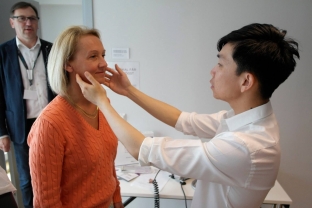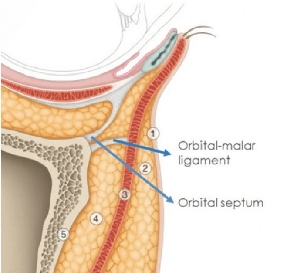Dr. Kieren Bong – head of the Essence Medical Clinic in Glasgow, lecturer at Baskerund University College in Norway, specializing in cosmetic dermatology, talks about the technique of rejuvenating the infraorbital region with dermal fillers based on hyaluronic acid.

The aging process of the infraorbital region is typically characterized by bone resorption, muscle atrophy, fat volume loss and thinning of the skin. Typically, infraorbital rejuvenation involves the surgical removal of excess tissue, muscle, and fat. This technique is based on the fact that facial aging is characterized by the presence of an excess amount of tissue. Over the past ten years, we have better understood the anatomy and pathogenesis of aging in this area. It is accepted that the restoration of volume in the infraorbital region is part of a comprehensive rejuvenation strategy and is achieved through collagen, hyaluronic acid, autologous fat and poly-L-lactic acid.
Today, patients are more interested in less invasive rejuvenation techniques. With the invention of hyaluronic acid dermal fillers designed specifically for the infraorbital region, it has become possible to correct deformities in the infraorbital region through a safe and effective procedure without the downtime associated with surgical procedures.
Why are hyaluronic acid fillers suitable for infraorbital rejuvenation?
Hyaluronic acid is a molecule that is part of the extracellular matrix of connective tissues, skin, joints and vitreous body of the eye. It is a polysaccharide, glycosaminoglycan, ideal for increasing tissue volume. The biocompatibility of hyaluronic acid, which reduces the risk of immunological reactions and rejection, is one of the most basic characteristics of hyaluronic acid. After injection, hyaluronic acid undergoes a slow process of isovolumetric degradation under the enzymatic action of hyaluronidase, which makes it possible to maintain the correction result longer.
In addition to the long-term effect, low risk of side effects and elasticity, the advantages of hyaluronic acid-based fillers include their superficial injection.
 A clear understanding of the anatomy of the infraorbital region – a prerequisite for safe and effective rejuvenation. The anatomy of the infraorbital region above the bone is as follows:
A clear understanding of the anatomy of the infraorbital region – a prerequisite for safe and effective rejuvenation. The anatomy of the infraorbital region above the bone is as follows:
- Leather.
- The superficial layer of fat.
- Circular muscle of the eye.
- Fat located under the orbicular muscle of the eye.
- Periosteum.
Infraorbital area rejuvenation technique with hyaluronic acid fillers
Important! Rejuvenation of the infraorbital region with dermal fillers – not an easy task. In addition to understanding the anatomy and pathogenesis of aging in this area, the physician must have experience with injectable fillers and the hyaluronic acid used.
The back of the chair should be tilted 30 degrees (from upright) with the patient's head resting on the headrest. It is necessary to conduct a rapid test to make sure that there is no excessive flabbiness of the eyelid. Next, the treated area is marked by outlining the upper and lower borders of the lacrimal sulcus. The lower edge of the orbit should be actively palpated and marked.
Hyaluronic acid dermal filler can be injected using a hypodermic needle or a 27 gauge blunt microcannula for more uniform filler placement. Despite the blunt tip, the 27-gauge microcannula can damage blood vessels.
The filler must be injected above the periosteum, under the orbicular muscle of the eye and below the orbital ridge. Small doses of filler are precisely injected along the lower edge of the orbit to soften the transition from orbital fat to zygomatic fat.
With a hypodermic needle, aspiration is recommended prior to filler injection to minimize the risk of entry into the vessel. I recommend using the sequential piercing technique. If the needle passes through the orbicular muscle of the eye, bruising may occur. Insertion of the filler through the orbital septum should be avoided as this will lead to the formation of a pseudoherniated orbital fat. To avoid this, it is necessary to press the edge of the orbit with the index finger of the free hand.
To minimize the risk of surface heterogeneity, after the injection, gently massage the treated area, however, with the right filler for the patient. Place ice packs on the treated area to promote vasoconstriction. I recommend that patients refrain from deep tissue massage for three weeks after the procedure.
Try not to inject a large amount of hyaluronic acid filler – it is better to correct the result four weeks after the procedure.
Side effects of infraorbital rejuvenation with hyaluronic acid fillers
Possible side effects of infraorbital rejuvenation with hyaluronic acid fillers are usually the result of incorrect product selection as well as incorrect administration.
- The risk of occurrence when using a hypodermic needle can be minimized by using a blunt-tipped microcannula and (if possible) stopping NSAIDs, vitamin E, alcohol and caffeine a few days before the procedure. Also, ice and gentle pressure on the treated area immediately after the injection will help minimize the risk of bruising.
- Lumpiness or uneven surface of the face – a typical side effect of any dermal filler, especially with high viscosity hyaluronic acid fillers.
- Inflammation at the injection site, including erythema and discomfort, occurs with the use of the needle and resolves after a couple of days.
- The risk of infection can be reduced by using an antiseptic and following an infection control protocol.
- Necrosis – a rather rare, but serious complication, the cause of which is damage to the vessels during injection, followed by local tissue necrosis. This type of risk can be minimized by using a blunt cannula.
- To prevent displacement of the filler, the filler should be injected above the periosteum, under the orbicularis oculi muscle, do not inject large amounts of product, and do not massage the treated area too aggressively.
According to Dr. Bong, the ideal hyaluronic acid-based filler for rejuvenation of the infraorbital region of the face is:
- relatively low concentration of hyaluronic acid;
- relatively low percentage of acid crosslinking;
- relatively low percentage of free hyaluronic acid;
- not granular;
- with the perfect balance of viscosity and elasticity;
- with the perfect balance of crosslinked and non-crosslinked hyaluronic acid.







Add a comment